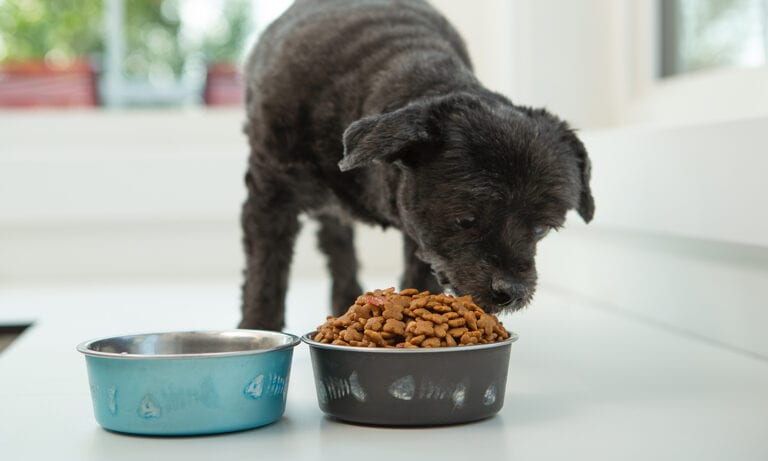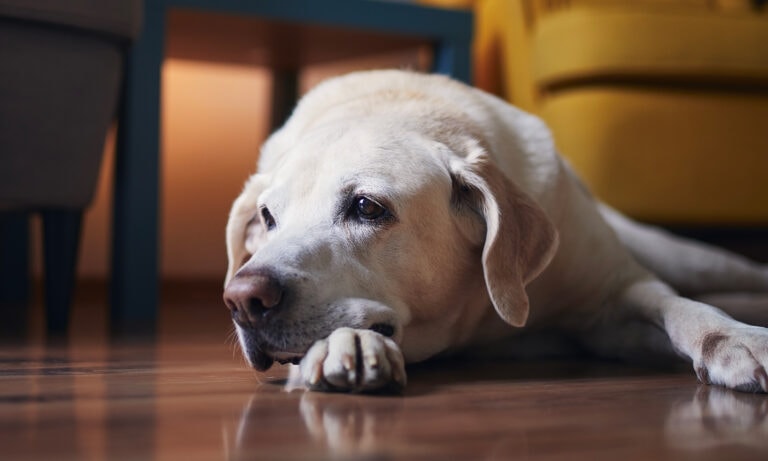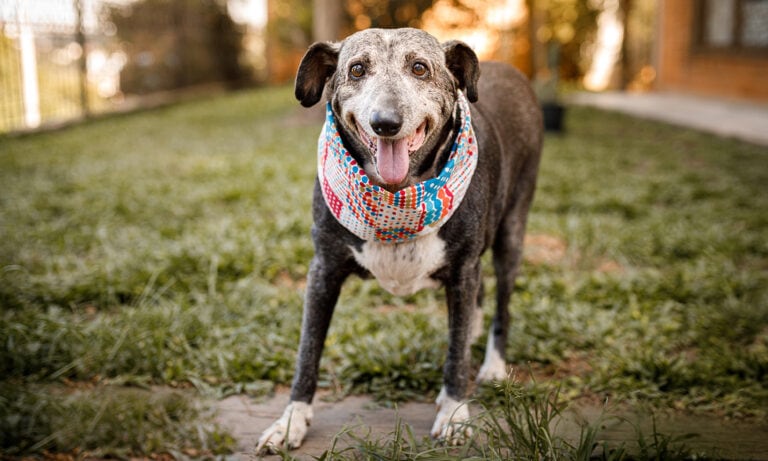The decision to spay or neuter a dog is one that many responsible pet parents make. But while the majority of discussions around this procedure focus on puppies or young adult dogs, there’s another demographic to consider: older dogs.
Choosing to spay or neuter an older dog can come with benefits, like reducing the risk of certain cancers—and challenges, like taking longer to heal post-surgery.
We spoke to vet experts to understand the advantages and potential drawbacks, providing a balanced perspective for those weighing the options.
Spaying and Neutering an Older Dog
Click to jump to each section.
How Old Is Too Old to Spay or Neuter a Dog?
However, there’s no definitive cutoff age for spaying or neutering a dog, says Dr. Scott Pendleton, DVM at Heritage Veterinary Care in Hopedale, Ohio.
Instead, the dog’s overall health is the main factor in determining whether a dog is a good candidate for these surgeries. As dogs age, they might develop certain health issues that could make surgery (and the required anesthesia) riskier.
Health problems such as heart disease, kidney issues or respiratory problems can complicate anesthesia and the recovery process. As such, conducting a thorough pre-surgical exam, including bloodwork, is crucial to assess a dog’s fitness for surgery.
The Pros and Cons of Spaying or Neutering an Older Dog
Benefits of Spaying or Neutering a Dog
Let’s start by taking a look at the benefits.
Reduction of Health Risks
According to Dr. Paige Adams, DVM, veterinarian at Etowah Veterinary Hospital in Marietta, Georgia, spaying or neutering an older dog offers several health benefits:
- Reduced risk of certain cancers: Spaying in female dogs eliminates the possibility of uterine and ovarian cancer, and significantly reduces the risk of mammary cancer. Neutering in males eliminates the risk of testicular cancer. Spaying and neutering can also eliminate certain cancers when caught early.
- Prevention of pyometra: Pyometra is a severe and often life-threatening uterine infection that can occur in female dogs. It results in the accumulation of pus in the uterus, leading to symptoms such as lethargy, increased thirst, fever and abdominal swelling. If an older female dog has not yet developed pyometra, spaying can remove the risk altogether. If they’ve already developed the condition, spaying can often cure it, especially if caught early.
- Reduced risk of benign prostatic hyperplasia (BPH): Intact older male dogs often develop noncancerous enlargement of the prostate gland, known as BPH. Symptoms can include difficulty urinating, bloody urine and constipation. Neutering prevents this condition from occurring and can reduce the symptoms if the condition has already developed.
- Prevention of hernias and perianal tumors: Intact older male dogs can develop perianal tumors near the rectal area. These can be painful and may require surgical removal. Hernias (protrusions of an organ through an abnormal opening in the muscle or tissue) can also develop. Neutering can significantly reduce the incidence of these conditions.
The vast majority of geriatric patients (older dogs in the last 20 percent of their lifespan) are spayed or neutered for therapeutic reasons. For male dogs, neutering is almost always done for prostate problems, such as having trouble urinating. In females, geriatric dogs are most commonly spayed due to pyometra or cycle irregularities.
Elimination of Reproductive Behaviors
Male dogs, regardless of age, have innate behaviors linked to their reproductive status. When intact, male dogs are more likely to:
- Mark territory: Marking with urine is a way to establish dominance and communicate with other dogs about their presence. This behavior can be seen inside the home, or on virtually any object or space the dog deems worthy of marking.
- Wandering: An intact male dog can be compelled to roam in search of a mate. This behavior can increase the risk of accidents, getting lost or potential altercations with other animals.
- Pestering: Intact male dogs can be particularly persistent when it comes to female dogs, especially those who are unspayed. While out in public, they might engage in behaviors such as persistent sniffing, following or attempting to mount the females. Moreover, it's not uncommon for intact males to show up uninvited at the homes of unspayed females in the neighborhood. This behavior can be bothersome and distressing for both the female dogs and their owners.
- Aggression: Hormonal surges can sometimes result in heightened aggression or dominance behaviors, leading to conflicts with other dogs or even risky situations with humans.
- Mounting: Intact males often display mounting (aka humping) behaviors. This can be directed at other animals, objects or even people, and can be a sign of dominance, play or other behavioral motivations.
Neutering can significantly diminish or eradicate these behaviors, making your dog more manageable and reducing risks associated with these actions.
Prevention of Unwanted Litters
Although a male dog’s sperm count decreases with age, most can breed until they die. And female dogs can still get pregnant at age 12 or even older. However, at this old age, female dogs often have serious complications during pregnancy or labor that put their lives and their pups’ lives at risk.
Health issues aside, not spaying or neutering your dog can lead to unwanted litters that contribute to the overpopulation of dogs. This means more animals wind up in shelters or homeless situations.
Spaying or neutering is a responsible step towards ensuring no unexpected litters occur, benefiting both the individual dog and the broader canine community.
Elimination of Periods in Females
Unspayed female dogs go through an estrous cycle, commonly referred to as "going into heat." During this cycle, which usually occurs about twice a year, they experience a phase called estrus.
Estrus is when they are receptive to mating and often exhibit a bloody vaginal discharge. This discharge can sometimes be quite noticeable and require pet parents to take extra precautions to manage the mess, including using special doggy diapers or restricting the dog to certain areas of the home.
By spaying a female dog, this estrous cycle is eliminated, along with the associated bleeding, providing relief from the periodic mess for pet parents.
Potential for Longer Lifespan
Most people would do anything to get a couple of extra years with their beloved pup. As it turns out, spaying and neutering could be the ticket.
According to a 2013 study from the University of Georgia, which analyzed over 70,000 animal medical records, neutered male dogs lived approximately 14 percent longer than their unaltered counterparts, and spayed female dogs lived about 26 percent longer. To put this in context, intact dogs had an average lifespan of 7.9 years, whereas altered dogs lived up to an average of 9.4 years.
Cost Savings
While spaying or neutering requires an upfront cost, it’s an investment that can lead to financial savings in the long term. Here’s why:
- Prevents reproductive system-related diseases and can save on hefty medical bills that arise from treatments, surgeries or long-term care associated with these conditions.
- Avoids unintended litters, which eliminates costs associated with prenatal care, birthing and puppy care.
- Reduces aggressive or wandering behaviors, which can mean fewer expenses related to injuries, lost-dog recoveries or property damage.
Potential Downsides of Spaying or Neutering an Older Dog
Now, let’s take a look at the potential drawbacks of spaying or neutering an older dog.
Anesthesia and Surgical Risks
“Anesthesia and surgery itself is always a risk,” says Adams. “Even if we do all of the pre-operative planning, bloodwork, etc., there is an inherent risk.”
General risks associated with anesthesia range from vomiting after waking up to life-threatening cardiac arrest. With surgery, some general risks can include infection, opening of the surgery site and excessive bleeding.
While these risks are low, older dogs might have heightened vulnerabilities, says Adams.
When older dogs with aging organs undergo anesthesia, complications can arise because their bodies might not process or eliminate the anesthetic agents as efficiently. This can result in delayed awakening and post-operative confusion. Older dogs might also have slower wound healing than younger dogs.
Additionally, pre-existing conditions such as heart disease or respiratory issues can complicate the surgical procedure. These conditions may remain undetected until the dog undergoes surgery, leading to unexpected challenges.
Given these potential complications, it’s crucial for a veterinarian to conduct a thorough pre-surgery evaluation on an older dog. With careful planning, these risks can be greatly minimized.
Weight Gain
One considerable con is weight gain. The surgery can slow their metabolism, causing weight accumulation.
“Older dogs will almost always gain 10 to 20 percent of their body weight after being spayed or neutered,” says Pendleton.
Due to this, pet parents should be ready to modify their dog’s exercise and diet regimen accordingly.
Switching to a weight-control dog food, like Hill’s Science Diet Adult Perfect Weight Chicken Recipe Dog Food, might help.
Changes in Coat
After spaying or neutering, some dogs experience alterations in their coat, says Adams.
Their coat may become thinner, while others may find the coat becomes thicker.
Not every dog undergoes these changes, and it’s not always a bad thing—just something to be aware of.
Post-Surgical Healing Time
Older dogs may take a little longer to heal from the surgical procedure than their younger counterparts, especially with a spay because it’s more invasive.
General guidelines suggest that pet parents should restrict their dogs’ exercise for 10 to 14 days after the surgery. Older dogs might take the full 14 days to recover—or even a bit longer.
This may be partly because older dogs have larger reproductive systems than puppies and, as a result, require larger incisions, which take longer to heal, says Adams. In general, older dogs also heal a bit slower than younger dogs.
Cost
The cost of spaying or neutering can be a concern for pet owners. The immediate expense can be substantial, particularly when the procedure is conducted at specialized veterinary clinics or if the dog requires extra health precautions.
However, as noted before, the procedure can result in long-term savings by preventing future medical expenses associated with reproductive complications or unintended pregnancies.
The Spaying and Neutering Surgery Process
Pre-Surgical Evaluation
Before the surgery, veterinarians conduct a comprehensive health assessment to ensure the dog is fit for the procedure. This evaluation might include:
- Health history: A veterinarian or veterinary technician will check your dog’s medical history, looking for anything that would contraindicate the surgery.
- Physical examination: This includes palpation of the abdomen, an examination of the chest, and assessment of the gums (to check for hydration status and good circulation). Your dog’s weight and vital signs will also be measured.
- Blood work: Older dogs should always have a blood panel done prior to surgery to look for underlying problems that may affect their ability to metabolize anesthesia or properly clot their blood, says Adams.
- Advanced testing: In older dogs, chest X-rays and an electrocardiogram (ECG) are often recommended to check for medical conditions in the heart or lungs that might increase the risk of an adverse reaction to anesthesia.
If the physical exam and lab work are satisfactory, the dog will be prepped for surgery.
Anesthesia
To ensure the dog doesn’t feel pain and remains still during the operation, general anesthesia is administered. This typically involves a pre-anesthetic sedative and pain-relieving combo that’s administered to the dog by injection, followed by an injectable agent that initiates unconsciousness.
The age of the dog might influence which medications are used.
“I choose my pre-medications based on the individual patient and avoid certain drugs and drug classes in older pets,” says Adams.
Fluids
Once the dog is thoroughly sedated, an area is shaved on a foreleg and prepared for an IV catheter. This catheter allows the veterinarian to administer fluids to the dog, which help maintain blood pressure.
This step is critical for senior dogs, who tend to have a slightly harder time maintaining their blood pressure while sleeping.
The catheter is also used to administer additional sedatives and anesthetics as needed during the procedure, and to allow for immediate venous access if an emergency occurs.
Breathing Tube
Next, an endotracheal tube (aka breathing tube) is placed into the dog’s trachea or windpipe via their mouth.
This tube delivers a continuous flow of oxygen to the dog and allows for the delivery of gas anesthetics, which may be required to keep the dog asleep during the procedure.
Surgery Prep
Female dogs are shaved between the end of the rib cage and the pelvic bone, and the males are shaved in the area from the penis to the scrotum.
The shaved spot is cleaned with an antiseptic, and the dog is moved into the surgical suite.
Surgical Procedure
For females, the ovaries and the uterus are removed through a single incision near the dog’s belly button. And for males, both testicles are removed through a single incision between the base of the penis and the scrotum.
Most veterinarians use dissolving sutures, so there is no need to have sutures removed at a later date.
Pendleton notes that, in older dogs, the sutures are typically placed closer together to help with faster healing.
Post-Operative Care
Once the surgery is complete, the focus shifts to recovery. The dog is moved to a quiet recovery area and closely monitored as the anesthesia wears off. Pain management is addressed through medications to ensure the dog’s comfort.
Instructions are provided to the pet parent regarding wound care, activity restrictions and concerning signs to watch for, such as swelling, redness or discharge from the incision.
If any unusual signs are noticed, a prompt checkup with the veterinarian is required.
FAQs About Spaying and Neutering Older Dogs
Q:
Will neutering an old dog calm him down?
Q:
Is neutering harder on older dogs?
Q:
Will neutering my dog affect their personality?
Q:
What restrictions do dogs have after being spayed or neutered?
A:There are a few essential restrictions dogs must adhere to following a spay or neuter procedure. Keeping your dog as calm as possible during the first two weeks is important. Avoid running, jumping and excessive playing. Strenuous activity increases your dog’s risk of developing swelling around the incision site, which could result in premature dissolving of sutures and opening of the incision.
It’s also essential for dogs to wear a protective collar, such as KONG Cloud Collar, to prevent them from biting or licking the incision.
More on spaying and neutering pets:
Share:











